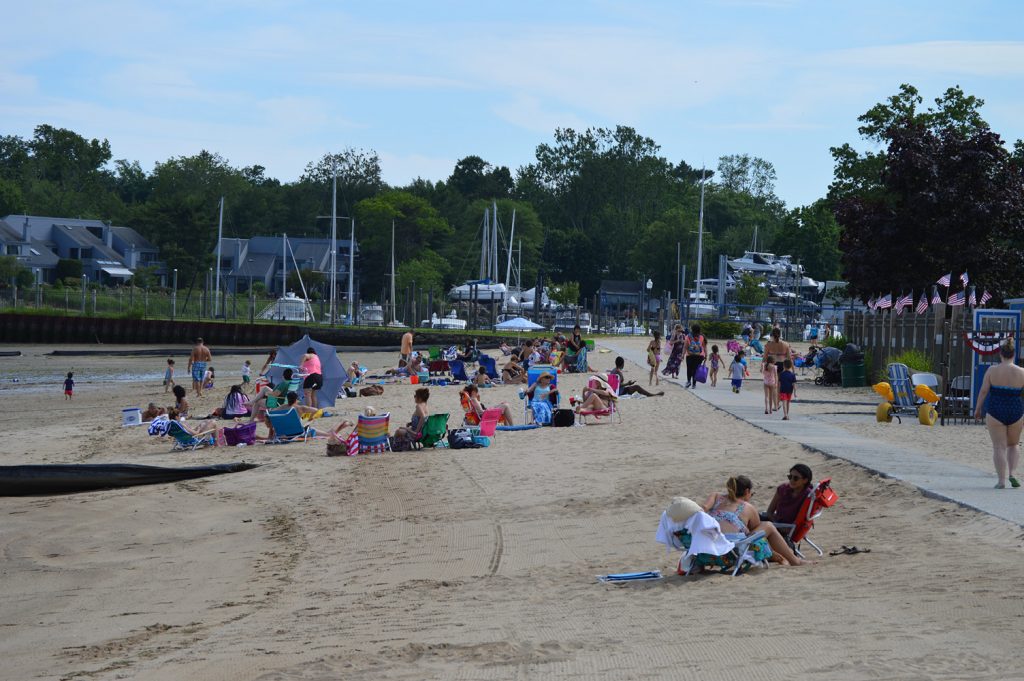By Martin Hain, Communications Specialist, Save the Sound
We are so fortunate that Long Island Sound is encircled by hundreds of beautiful beaches. Millions of people visit many of these beaches each year, supporting our coastal economies and forging personal bonds with the Sound estuary. However, the sad reality is that a lot of these beaches—including many of the best—are fenced off and inaccessible because they have become privately owned. Many others are restricted to local residents only, often with a fee required for access. This creates an impossible situation for families who may live close to a beach but have no means to access and enjoy it. This is not right.

Harbor Island Park Beach in Mamaroneck, NY offers access to all as long as they purchase a pass, which is discounted for local residents.
Of the 200+ beaches on the Sound, fully one-third (76) are private; these are located predominantly in Nassau, Suffolk, and Westchester counties, and New York City. Additionally, there are 21 beaches in New York that are restricted to local residents only. In Connecticut, a successful lawsuit brought by a resident made excluding non-residents from local beaches illegal. This created another class of beaches that are designed as “public” but require visitors to get passes at a different location and in some cases during business hours only, making spontaneous same-day visits difficult. That leaves approximately 90 beaches that are open to all visitors, mostly located in Connecticut. Even then, though, most charge a fee for parking and/or entry, and some of those are priced to be out of reach to low-income residents, especially those with large families.
As we face a warming climate and an American racial justice reckoning, Save the Sound calls on our coastal communities to do away with local ordinances that make it hard or impossible for the wider public to enjoy the unique pleasures of a day at the beach. Reasonable beach access fees can spread the cost of beach maintenance and staffing across all of the people who visit the beach, without overburdening or excluding non-local beachgoers. The beach monitoring and beach sand replenishment that coastal communities rely on are funded with state and federal dollars, allowing everyone access to the water below the high tide line—but most people don’t know this is their “Public Trust Right” including the guards who check passes and collect fees! People who use their right to access the “wet beach” are frequently told they cannot use any of the facilities at the beach including the protection of the lifeguards.
In an effort to help the public navigate this complex landscape of access requirements and find new public beaches to explore, we have added a “Beach Access” layer on the Sound Health Explorer site (soundhealthexplorer.org/swimmable), which tracks beach health data all the way back to 2003. We have also included information on current beach fees, special closures due to COVID, and other beach-specific information on each beach page on the site. We hope this supports more people getting out on a beautiful Long Island Sound beach this summer.
Save the Sound is also excited to announce our 2018-2020 Long Island Sound Beach Report, expected in early June. This comprehensive report takes a look at historic water quality data collected at 200+ beaches around Long Island Sound and compiles it along with precipitation data to create an easy to understand breakdown with grades for each beach for each year from 2018-2020. Our analysis focuses on how our beaches rank when measured against the Connecticut and New York state criteria for safe swimming, which is fecal bacteria levels measured weekly during the swimming season. We have combined the beach monitoring data with rainfall data to show how wet or dry weather influences conditions at each beach. Tracking fluctuations in water quality connected to rainfall provides insights to possible pollution sources that can then be investigated, confirmed, and addressed. Our Beach Report—and more reports on Long Island Sound health—will be available for download at savethesound.org/what-we-do/healthy-waters/report-cards-grades.
Get out there this summer and enjoy your right to a clean, accessible beach! ■
